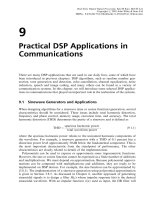Tài liệu Chapter 9: Miscellaneous catalytic reactions in aqueous media pdf
Bạn đang xem bản rút gọn của tài liệu. Xem và tải ngay bản đầy đủ của tài liệu tại đây (469.91 KB, 13 trang )
Chapter 9
Miscellaneous catalytic reactions in aqueous media
The realm of aqueous organometallic catalysis incorporates many more
reactions and catalysts than discussed in the preceeding chapters. However,
these were not investigated in so much detail as, for instance, hydrogenation
or hydroformylation; some of them are mentioned only here and there. An
attempt is made to give a representative sample of these studies. At the end
of this chapter, a few findings will be briefly mentioned, which do have
some connection to aqueous organometallic catalysis in the sense we used
this term throughout this book, but which perhaps could be best categorized
as emerging techniques.
9.1 A
queous organometallic catalysis under traditional
conditions
In this part of the chapter we shall look at examples of catalytic
isomerization, hydration, cyanation, hydrocyanation, hydrophosphination
and animation reactions. “Traditional conditions” refer to ranges of
temperature and pressure within which water behaves as we are used to it
normally, i.e it forms a highly polar liquid phase, capable of dissolving
electrolytes and polar substances. Under such conditions water is a poor
solvent for nonpolar organic compounds which –with appropriate organic
solvents– allows the use of aqueous-organic biphasic media for
organometallic catalysis. A guide to the literature of these studies is found in
Table 9.1.
Isomerization is a frequent side-reaction of catalytic transformations of
olefins, however, it can be a very useful synthetic method, as well. One of
the best-known examples is the enantioselective allylamine enamine
isomerization catalyzed by or which is the
crucial step in the industrial synthesis of L-menthol by Takasago [42]
265
266
Chapter 9
(performed under unhydrous conditions). Especially valuable feature of
isomerizations is in that all atoms of the starting compound are incorporated
into the product, respresenting a 100 % atom economy.
Miscellaneous catalytic reactions in aqueous media
267
which is a precursor of ROM polymerization of cyclic
dienes has also been found to possess good alkene isomerization activity [1].
Among others it catalyzed the isomerization of allylphenyl ether to a
vinylphenyl ether (Scheme 9.1) at room temperature. Allyl ethers are stable
to acids and bases, while vinyl ethers are easily cleaved in acidic solutions.
Therefore this isomerization gives a mild method for removal of protecting
allyl groups under exceedingly mild conditions.
In an interesting reaction, reshuffling of functional groups can be
achieved in the rearrangement of homoallylic
alcohols (Scheme 9.2) [8,9]. Allylic alcohols also react the same manner,
however, when both kind of olefinic bonds are present in the same molecule,
than it is the homoallylic moiety which reacts exclusively.
In water-heptane biphasic systems, allylic alcohols underwent
rearrangement to the corresponding carbonyl compounds with a catalyst
prepared in situ from and TPPTS. The reactions proceeded very
fast (TOF up to ) and in most cases provided the carbonyl products
quantitatively. The industrially interesting geraniol was isomerized mostly
to citronellal, albeit octatrienes and tricyclene were also produced. With an
increase of the pH of the aqueous phase the yield of isomerization decreased
somewhat (from 48 % to 40 %), however the selectivity towards the
268
Chapter 9
formation of citronellal was found to increase from 50 % to 70 % (Scheme
9.3)
[10].
Isomerization processes have been used as test reactions in developing
microreactors for dynamic, high throughput screening of fluid/liquid
molecular catalysis [45].
Miscellaneous catalytic reactions in aqueous media
269
The stable ruthenium alkylidenes, used for catalysis of ring opening
metathesis polymerizations, were found to exchange the alkylidene proton
for a deuteron in or in (Scheme 9.4) [13].
The reaction is thought to proceed with the dissociation of followed
by release of the extra charge of the ruthenium complex by dissociating a
proton from the alkylidene ligand. Such an exchange in itself does not lead
to the decomposition of the alkylidene complex. Nevertheless, both the
formation of the charged species, both the intermediate existence of the
carbyne complex (Scheme 9.5) may open new ways to the deterioration of
the ROMP catalysts.
Isotope exchange methods are useful tools for labeling important
compounds, such as drugs, and for mechanistic investigations in reaction
kinetics. During catalytic hydrogenations in homogeneous aqueous solutions
or in aqueous-organic biphasic systems there is ample possibility for H/D
exchange between hydrogen in the gas phase and the solvent (e.g. reaction
9.1) if or is used.









